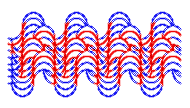
 |
| From Quibbling by Carolyn Guyer. Published by Eastgate Systems. |
At the ripe old age of six years, Carolyn Guyer's Quibbling (1992) is one of the mothers of feminist hypertext and it is still one of the best. I have had two copies of Quibbling. The subversive power of its sensuous discourse is so strong that the first two times I tried to read it it crashed my computer. After the initial attempt, it vaporized into air and was nowhere to be found. The second time it was miraculously waiting after all of the appropriate recovery functions had been performed on the rest of my systems. Prophetically, it seems to emit "a buzz like static interference" ("B.B. Daze," Quibbling) when forced to come into contact with mere binary systems.
Quibbling is an evocative meditation on connections. A symphonic intertwining of hands and toes, quotes and colours, love affairs and daily rituals, Guyer's novel traces the landscape of the sensuality of existence. It is woven together of bits of glass, windows and moons, the curve of necklines and the hint of breasts, moon-dew and menstrual blood, swaths of cloth, the sweep of hems, strands of music and beloved bowls. The literal ebb and flow of Guyer's l'écriture feminine is so immediate that I found myself breathing in time to the tempo of its rhythms. In fact, it gave me such a surprisingly intense awareness of my own breathing and the rhythms of my body that I felt as if I were underwater, as if the "deep liquid sensation of boundlessness and envelopment" ("aswim," Quibbling) were my own and not her characters'. Like Shelley Jackson's Patchwork Girl, Guyer's text is an experience that cries out for an answer. Carolyn Guyer:
Home Page and Links to Other Works.
URL: http://mothermillennia.org/Carolyn/
Quibbling. Software. Eastgate Systems, 1992.
Catalogue URL: http://www.eastgate.com/catalog/Quibbling.html

Carolyn Guertin